Illustrating Characters and Enviromants for Multiple Games and in Various Art Styles
What can we learn from the techniques of the Old Masters to help us create more than varied and emotionally meaningful gaming experiences? And how must nosotros get nearly adapting these classical art techniques when we add together video gaming's unique element of interactivity?
To explore these questions, this article examines the psychology of shapes and dynamic composition, which are the focus of a series of talks I recently completed effectually North America (kindly supported past Gbanga, Swissnex, and the Swiss Arts Quango, Pro Helvetia). I firmly believe that dynamic composition should be the topmost consideration for developers wishing to shape the emotional experience of their video games. Dynamic composition brings together several topics from my book -- Drawing Basics and Video Game Fine art: Archetype to Cutting Edge Art Techniques for Winning Video Game Design -- and is chiefly composed of iv elements:
- Character shape
- Character animations
- Environs shapes
- Pathways
Video games rely on the very same design principles -- perspective, form, value, etc. -- which classical artists employed to create the illusion that the boob tube (or canvass) is a window into an imagined earth. These pattern techniques also serve a second purpose as applicable to game pattern, which is their artful value, and application in visual narratives.
A better understanding of traditional art techniques, and video game aesthetics, will lead to richer gaming experiences, and may require a rethinking of established studio structures and the collaborative roles of game designers and artists. Because, as we'll see, making bridges betwixt classical art and video games has implications for game designers besides.
We'll explore how these elements work together aesthetically, and finish by applying the techniques learned to game design. But earlier diving into dynamic composition we'll have a quick wait at the basic elements of composition (lines, shapes, and volumes); their psychological affects; and their awarding in classical painting and composition.
The Psychology of Lines, Shapes, and Volumes
The art world has inverse drastically over the by hundred years with the coming of Modern Art. Prior to the 20th Century, artists would follow a tradition of arts and crafts and design practice, which had been steadily evolving for over 2000 years for the purpose of communicating pictorial stories. What Mod Art did was to make clean the artistic slate by deliberately breaking with tradition and classical art techniques. This had the invigorating event of freeing artists to explore individual styles and new forms of self-expression.
We at present find ourselves in a civilization that appreciates that you lot and I will respond to art in different ways based on our unique life experiences -- experiences that inform the way in which we individually interpret and give pregnant to the world around us. The inherent ambiguity concerning interpretation is largely responsible for what makes the creative process and art appreciation so mysterious and personal. However the aesthetics of art weren't always studied from this perspective alone. Classical paintings had a definite purpose -- particularly in the context of religious paintings -- and were therefore crafted using design techniques that have a timeless psychological basis, and are therefore easier to ascertain.
Every bit video game designers it's important that we capeesh both modern and classical standpoints on aesthetics, although classical techniques are of more practical do good to u.s.a. as artists and designers. We can begin by examining the root of visual design, in the grade lines, shapes, and volumes.
Considering reality is and so visually complex, professional person artists conceptually reduce objects to unproblematic lines, shapes, and volumes, to simplify the task of rendering reality. This abstraction is something that is familiar to 3D digital artists working in such programs as Maya or 3ds Max, where each object -- whether it's a effigy, an surround, or a prop -- will kickoff its life as a primitive shape. Aside from the applied benefit of simplification, these shapes have been consistently associated with the post-obit aesthetic concepts throughout art history:
- Circle: innocence, youth, energy, femininity
- Square: maturity, stability, residuum, stubbornness
- Triangle: aggression, masculinity, forcefulness
Why we associate these shapes with their corresponding artful concepts has to do with our existent-life experiences, and the sense of touch. As kids, much of how nosotros understand the earth around usa is first learned through touch. By feeling our mode around and comparing textures, we speedily develop a mental shorthand for visually assessing the general characteristics of objects based on feel.
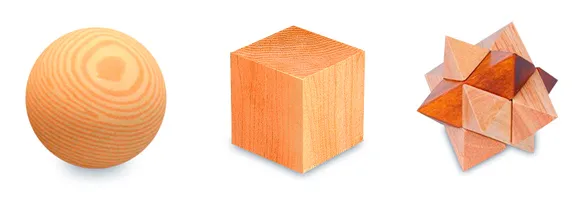
Picture the in a higher place iii wooden objects -- the sphere, cube, and star -- placed on a tabular array. At present imagine shaking that table. The circular sphere would begin rolling around -- demonstrating its dynamic backdrop -- while the cube would stay in place. Now imagine somebody throwing the sphere and star towards you for you to grab. Y'all'd instinctively hesitate to grab the star, even if y'all knew it wouldn't damage you, based on your learned response to sharp objects, in contrast to soft and round shapes.
Note that a curved line tin can be represented as a circular shape, or spherical volume; a direct upright or horizontal line, as a foursquare, or cube; and an angular line as a triangle, or pyramid. [For convenience, I volition refer to each group past its shape].
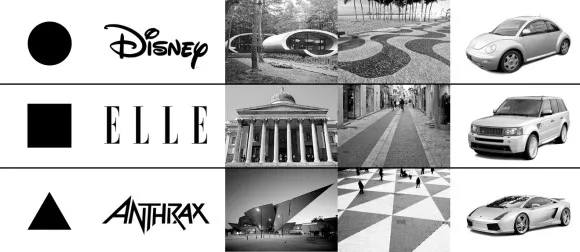
Click for larger version.
As artists, we take reward of our audience's existent-life experiences and the sense of bear on, and comprise these concepts (oft intuitively) into our artwork. See for yourself in the to a higher place analogy how, irrespective of the design discipline, the circle, square, and triangle, have been respectively integrated (from left to right) into logos, architecture design, decorative pavements, and vehicle designs.
The dynamic curves of Disney'south logo, which references the circle, are echoed in the curved pattern of a beachside promenade -- encouraging united states of america to visually and physically experience the objects in a dynamic way.
The upright lines of the square requite united states a sense of stability in the form of pillars fronting the National Gallery in London; and echoed in the straight lines of the Range Rover, designed to elicit feelings of safety, and composure.
While the edgy triangle is embedded in the logo of thrash metal band, Anthrax; besides as Frederic C. Hamilton building in Denver, Us; and the aggressively sporty lines of the Lamborghini.
Try to imagine how each object would look if yous were to switch shape concepts so that, for instance, the Disney logo was based on the angularity of the Anthrax logo -- a shape concept completely inappropriate for the make.
These psychological associations with master shapes allow us to orientate them forth a shape spectrum of emotions, confronting which characters and objects can be measured.
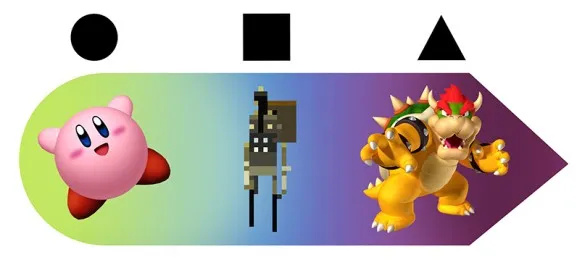
The shape spectrum of emotions should NOT be used as a design formula -- just equally a conceptual tool to assess artwork and place problem areas.
The psychological basis of these shapes means that they are a timeless feature of art, assuasive usa to find relationships betwixt seemingly disparate artworks, and better empathize the aesthetics of video games. Permit'south take a await at how these basic shapes accept been used in classical art to influence the viewer's emotions.
Lines, Shapes, and Composition in Traditional Art
Classical composition is an of import awarding for main shapes, employed by the Old Masters to influence the artful qualities of an artwork. What is classical composition, and why is it such an important artistic tool?
Classical artists would etch their paintings upon a system of lines that were designed to guide the viewer'southward eye around the prototype. These line-based compositions helped to organize elements in a painting -- making the image easier to read. But, as we know, primary lines and shapes also have an artful value, which relates to a composition'southward second purpose.
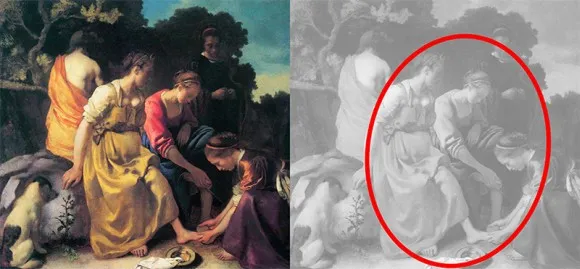
Diana and Her Companions (c. 1655), Johannes Vermeer
In the painting above, Vermeer has used a composition based on a curving line -- giving viewers a visual impression of delicate and continuous movement. Each chemical element -- from the primal figure'south right arm, to the cloth on the footing -- has been deliberately placed and shaped to reinforce this round composition. Take a longer look at this painting and you'll find many more composition lines echoing this concept.
Such line-based constructions were designed to be implicit -- the artist's hidden secret -- affecting viewers on a hidden level. Viewers could and so explore the painting seemingly at their ain will, unaware of the composition'due south influence. The impressions these implicit pathways projected were capable of telling a visual narrative in themselves.
At present contrast Vermeer'due south painting with that of Rubens' Massacre of the Innocents (c. 1611-1612) below. Rather than use a system of delicately curving composition lines, Rubens has based his painting on angular lines to communicate the violent topic of the painting. Rubens has skillfully placed the majority of the male person figures in the upper triangle, trampling the females in the lower portion of the painting. All the same the lines lonely describe a collision of forces.
Take a moment to capeesh the complexity and details of both the Vermeer and Rubens paintings. The beauty of classical limerick is that information technology enables artists to reduce complex images to more curtailed visual statements. At present imagine setting this complex arrangement of visual elements in movement, as in a typical video game, and a elementary composition becomes even more necessary to deal with the increased visual noise.
The simpler a visual statement, the easier information technology is for audiences to engage with your artistic message.
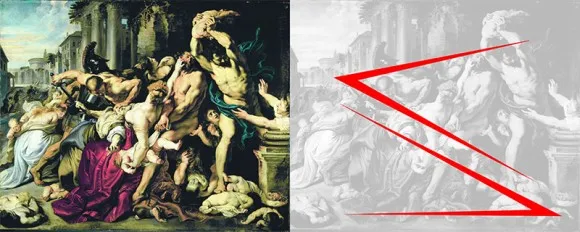
Massacre of the Innocents (c. 1611-1612), Peter Paul Rubens
The type of composition an artist designs -- whether information technology's delicate or athwart, for example -- should reinforce the emotional message of the artwork. Imagine substituting the compositional lines of one painting for the other, applying Vermeer'south curved lines to Massacre of the Innocents, and vice versa. What we'd detect is that each artists emotional intent would exist significantly weakened, with Massacre of the Innocents becoming more than elegant, despite its roughshod theme.
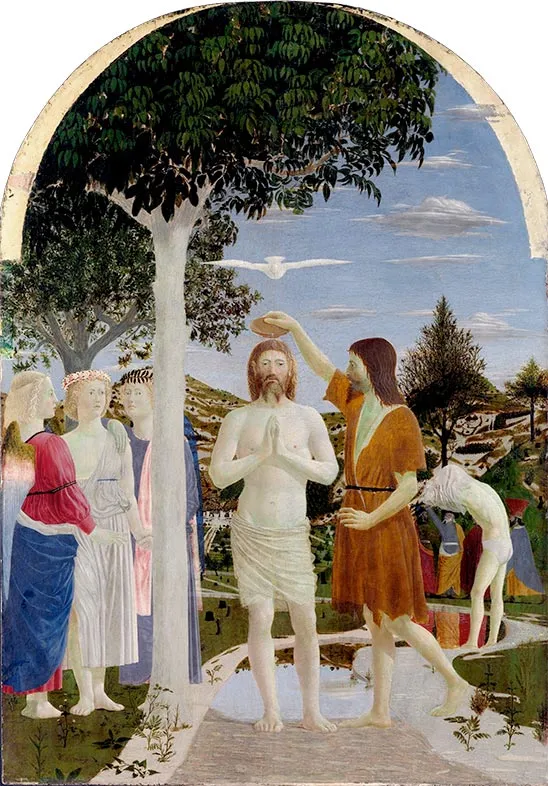
The Baptism of Christ (c. 1448-1450), Piero della Francesca
The composition of The Baptism of Christ by Piero della Francesca (c. 1415-1492) aligns itself with the straight upright and horizontal lines of the square -- which is located in the middle of the shape spectrum of emotions. Although at that place are some curved lines within the epitome, information technology is dominated past the verticality of Christ, and echoed in the tree, secondary figures, and the horizontal lines of the white dove. This vertical motif is largely responsible for the impression of stillness that we feel when looking at the painting.
A useful analogy to sympathise the effects of composition is to liken the technique to intonation in speech. Irrespective of the words in a speech, the rhythm and tone of delivery tin can completely modify the emotional message of what somebody is proverb.
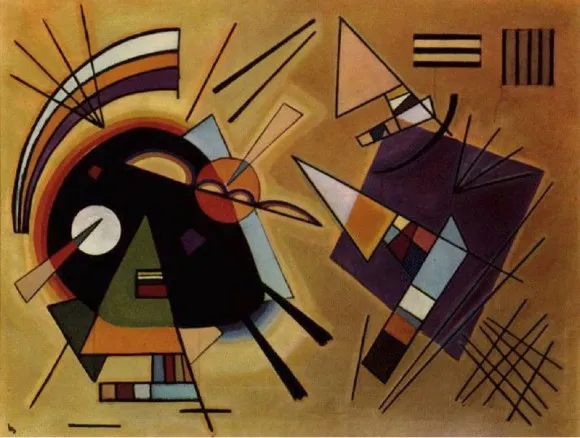
Black and Violet (1923), Wassily Kandinsky
With the invention of the photographic photographic camera in more recent times, the emphasis on line-based compositions shifted, as artists became influenced by the manner in which the photographic camera registered reality -- in terms of calorie-free and shadow shapes. Wassily Kandinsky (1866), who was very much a Modernistic Artist, did away with representational fine art altogether and withal his classical training meant he besides appreciated the importance of composition:
"The content of a piece of work of art finds its expression in the composition [...] in the sum of the tensions inwardly organized for the piece of work."
- Kandinsky, Point and Line to Plane (1926)
Throughout fine art history, basic shapes and limerick have been a primary artistic tool used to organize a work of art, and shape the aesthetic qualities of images. We should therefore find a style to apply this technique to video games. We have a conceptual problem, still, in translating classical composition to video games: the player.
The higher up paintings represent a static medium. Although society and cultural tastes alter over time, the artwork and the experience of looking at a painting remains relatively unchanged. Not and then with video games. There is no one single bespeak of view in video games, because the medium'due south interactivity allows players to motility inside virtual environments at will. So how do we go about translating classical techniques from a static medium to the dynamic worlds of video games? The answer, every bit hoped, is very simple.
Dynamic Composition
Finding a solution for translating classical limerick to video games is fabricated unproblematic if we consider the basic components of the technique. Composition is nothing more than the act of combining parts or elements to form a whole. As you volition retrieve from the previous section, the bones elements of classical limerick are little more than lines and shapes. If we can identify where these elements are to exist found pervasively in video games -- so that the role player is always aware of them irrespective of where they are inside the virtual world -- we tin can begin to define dynamic composition, as is applicable to video games.
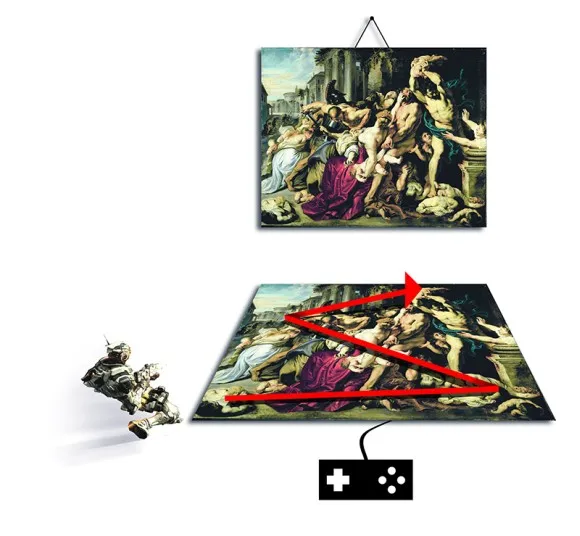
The answer is revealed if we conceptually take the lines and shapes plant in a classical painting, lay the composition downward apartment on the ground, and care for the image like a top-downwards map. The lines that nosotros would implicitly trace with our optics when looking at a classical painting, now become pathways along which we tin travel through a three-dimensional environment.
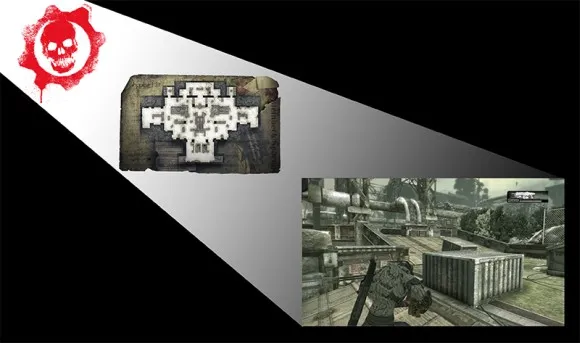
Logo, multiplayer map, and in-game screenshot from the Gears of War franchise, past Epic Games.
The meticulous design that has gone into the Gears of War franchise is an excellent instance of translating classical blueprint concepts to interactive experiences. In the pinnacle-left nosotros have the Gears of War logo that, merely like every good logo should, embodies the feel of the game in one poignant visual statement. The artists at Epic have and so projected the skull motif onto their level designs (detect the abstract center sockets, nose, and rima oris of the multiplayer map).
Conceptually this multiplayer map is very close to a painting, in that our eyes can trace implicit lines around the level'due south corridors without the ability to physically interact with the artwork. However video games go i step further, in that the projection of the skull motif also represents a three-dimensional environment -- visual lines on the multiplayer map, go pathways in a 3D virtual environment.
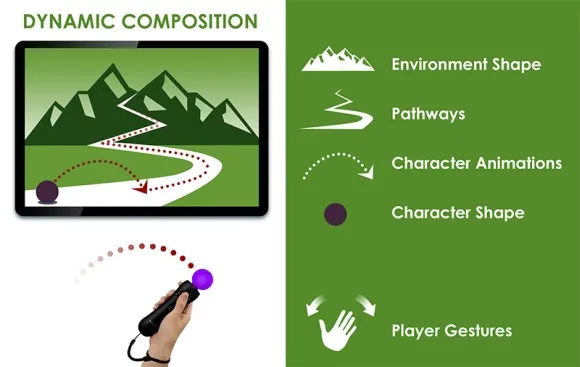
Pathways within an environment are only one part of dynamic composition. To fully empathise dynamic composition, we must take into account the 5 elements in the illustration in a higher place, and their relationships to each other:
- Graphic symbol shape
- Graphic symbol animations
- Environs shape
- Pathways
- Player gestures
Player gestures are not then much a part of dynamic limerick, which relates to on-screen images. However, video gaming'southward interactivity means that a player's actions are closely bound to the visual experience, and must also be considered in this context.
Over the grade of the next five sections we will examine each aspect of dynamic composition, with the aid of our principal shapes: the circumvolve, square, and triangle. We will additionally examine the player's part in a video game artwork, earlier applying the combined knowledge to game blueprint. We will begin with character shape, and simultaneously explore the narrative possibilities of dynamic graphic symbol shapes.
Character Shapes and Graphic symbol Evolution
The before department of this article explored the aesthetic sensations that nosotros associate with primary shapes. In this section we will expect at how these shapes tin can help u.s.a. make sense of various character designs in the context of dynamic composition. The characters in Nintendo'south Mario games make for corking examples for this awarding.
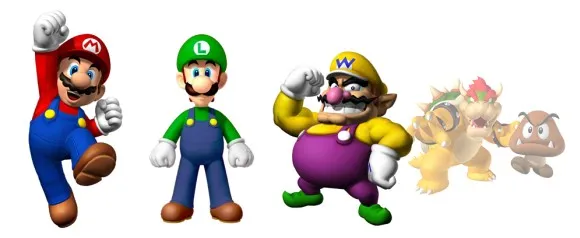
Nintendo characters from left to right: Mario, Luigi, Wario, Bowser, and a Goomba
How would you describe Mario'southward personality? Possibly: dynamic, youthful, positive. It's therefore no surprise to find that everything about Mario'due south design is based on the circular concept -- from his spherical trunk, to his round moustache.
Luigi'due south supportive, brotherly personality tin can too be evidenced in the verticality of his effigy, which references the rectangle in contrast to Mario'southward round shape. While Wario -- and well-nigh every enemy within the Mario universe -- is aligned to the ambitious triangle.
In actual fact, what we're looking at is the same graphic symbol! The artists at Nintendo take only taken Mario's torso and dialled the forms to be softer or sharper for different aesthetic effects based on the circle (Mario), square (Luigi), and triangle (Wario).
Just what if Mario, Luigi, and Wario indeed represented i grapheme that dynamically inverse over the course of a narrative? The question relates to the way that we treat graphic symbol evolution in video games.
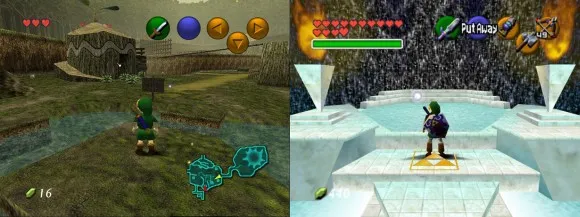
Zelda: Ocarina of Time (1998), Nintendo
Accept a look at the screenshots from one of my all-fourth dimension favorite games, Zelda: Ocarina of Time (1998). The screen on the left depicts Link early on in his quest, while the correct-side paradigm shows Link later on y'all've helped him boxing his way through many dungeons and large dominate fights. How do nosotros know that Link has grown in strength and ability during the course of this game? The show is not where most would expect to find information technology -- in the physical appearance of the character -- but in the user-interface. Link on the left has fewer hearts and a single sword equipped; and Link on the right has more than hearts and many more weapons and gadgets.
While user-interfaces brand sense to experienced video game players, those unfamiliar with the medium rightfully expect to run into a visible change in the central grapheme -- as occurs with actors in theatre and movies. Video gaming's treatment of grapheme development is the equivalent of an histrion verbally stating, "I am now stronger and more confident!" while his posture and behavior remains the same.
To create realistic and emotionally richer narratives we must begin treating video game characters as existent people with a breadth of emotions. Every bit the French Romantic painter, Eugene Delacroix (1798-1863), wrote on the topic of personalities:
"There may exist ten different people in one [person], and sometimes all ten appear within a single 60 minutes."
- from The Journal of Eugene Delacroix
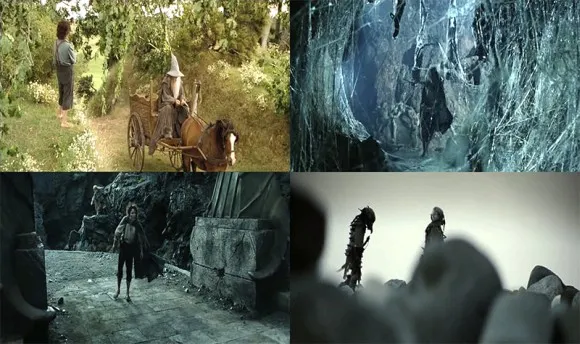
Lord of the Rings Trilogy (2001-2003), directed by Peter Jackson, New Line Cinema
Delacroix's remark extends to narratives and the fact that characters never starting time and finish in the same state. A narrative implies that a character has gone through an emotional change, which should exist made visible for viewers to comprehend. Frodo's character in the Lord of the Rings Trilogy, performed by Elijah Woods, illustrates how dynamic body language communicates his character's mental and concrete state: from mock indignation; to a fevered shuffle; panicked run; and an exhausted shock.

Grumpy in Snow White and the Seven Dwarfs (1937), Disney. Sequence animated by Beak Tytla.
Disney animators from animation's Golden Age not only made a point of understanding the emotions of the character, but likewise understanding what the character is thinking. A character expressing its thoughts and motivations instantly appeared more than lifelike.
The above sequence is featured in the must-accept book, The Illusion of Life: Disney Animation (Disney Editions 1995) past Frank Thomas and Ollie Johnston, in which Grumpy has but received a good-bye kiss from Snow White. Discover how, from right to left, the ambitious angularity in his gestures soften to gentle curves equally his temper dissolves.
Such dynamic character animations do appear in games like Resident Evil -- where the protagonist becomes physically dumb when poisoned or injured -- nonetheless this has more to practise with communicating the character'due south health stats -- much like a user-interface icon -- than an emotional purpose.
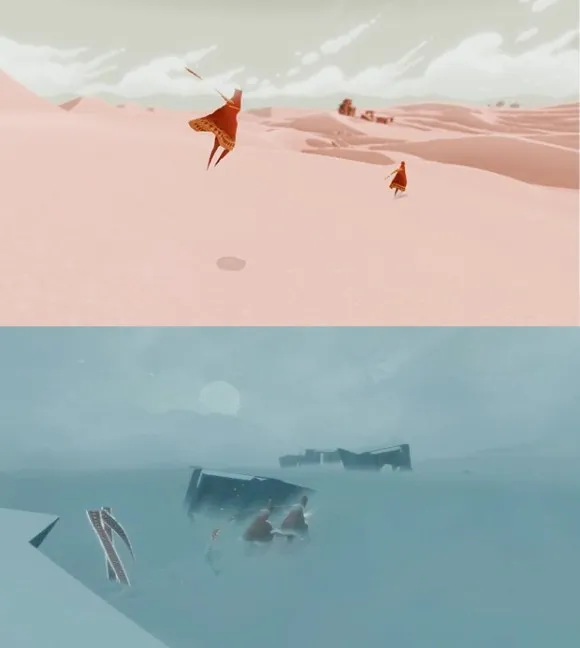
Journey (2012), thatgamecompany
To engagement, the near successful game to express the playable grapheme'due south emotions through concrete gestures is thatgamecompany's, Journey (2012). In the opening sections of the game, the character has an upright posture and jumps freely and gracefully. Only nosotros witness a delicate shift in the grapheme's concrete state every bit nosotros somewhen guide information technology up into the storm where information technology begins to hunch forward confronting the pounding winds.
Perhaps thatgamecompany could have included graphic symbol animations that communicate a sense of fright for the darker underground levels where the thespian is offset confronted by a threat from flight Guardians. This may have made the concluding flight under blueish heaven fifty-fifty more cathartic.
The fact that players have a strong emotional empathy for their on-screen avatars will let game designers to bring more emotional subtlety to video game experiences through increased use of dynamic character shapes. A character'south shape tin also be adjusted with a costume alter; however, its physical posture is the strongest and broadest visual clue to their inner feelings.
This brings united states of america to another attribute of dynamic composition associated with the character, and that is grapheme animations in terms of jump arcs and lines of move, which nosotros'll explore in the next department.
Character Animations
The subtle gesture of a hand or movement of a character's head are animations which are relatively indecipherable at low resolutions, or when the character is in movement. Animations that are visually more comprehensible include character jump arcs and general lines of movement. Because character movement on this broader scale can be conveniently visualized as lines, nosotros can consider how shaping such animations may touch the video game aesthetically.
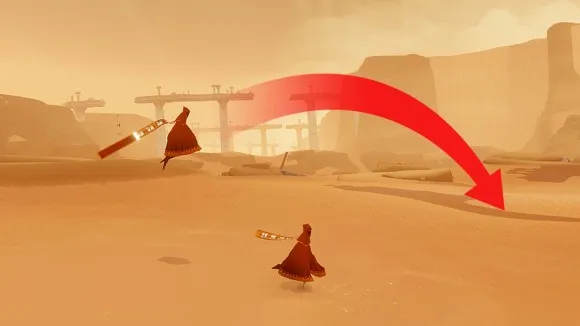
Journey, thatgamecompany
When a role player presses the jump button in the opening levels of Journey, the character jumps gracefully across the screen (as illustrated above).
The unsaid line that this jump arc creates -- made explicit past the character's trailing scarf -- is aesthetically aligned to the circular composition in Vermeer's Diana and Her Companions.
Watch the video below -- featuring, Journey, Superbrothers: Sword and Sworcery (2011), and Trounce (2010) -- and movie a light trail behind the characters as each travels through its respective video game environment. Can you align the animations to the circle, square, or triangle?
You should find that the lines of movement communicate a variety of emotions ranging from delicate and dynamic (curved lines); slow and peaceful (straight uprights and horizontals); and aggressive (angular). In designing a grapheme'southward movements it'southward vital to choose lines that complement the emotions you would like players to experience.
Every bit with character shapes in the previous section, we also tend to design character animations with one style of motility used consistently throughout the game. Video games being such a dynamic medium, there'south no reason why we tin't design experiences that accept reward of the whole range of possible animations to communicate more than complex narratives.
A game's photographic camera movement relates closely to graphic symbol animation -- especially in kickoff person games where it becomes the principal tool for communicating the in-game characters state of heed. In a kickoff person game, nosotros must imagine that the photographic camera represents the perspective of a living-breathing person, capable of feeling and expressing a whole range of emotions.
The video above illustrates two contrasting camera animations: the gentler photographic camera of Halo: Combat Evolved by Bungie, and the ambitious camera of Epic's Gears of War 3. Halo gives the role player a feeling of smooth elegance (more so in the earlier games), elevating Master Chief to a higher place the edgier, and aggressive movements of the enemy. While Gears of War has an edgy and aggressive aesthetic throughout -- implying that Delta Squad and the Locust Horde are on the same moral level as each other.
These examples highlight the importance of photographic camera animations in the context of dynamic composition. Now that nosotros accept character shapes and animations covered, it's time to consider the character in relation to its surroundings.
Character Shape Versus Surround Shape
A character's environment are a key part of dynamic composition considering the environs normally takes upward much of the visual frame. (Please note that environment here likewise includes secondary characters and enemies.) We tin respond emotionally to characters based on their shape and blitheness alone, even so it'south only once we see characters in an environs that a narrative emerges.
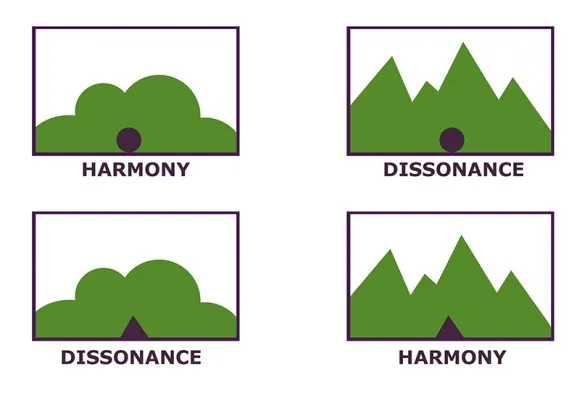
The illustrations in a higher place represent a grapheme (imperial) in an environs (greenish). A circular character in a circular environment (summit-left) exhibits a sense of harmony because the character's shape is echoed in its surroundings. The echo gives us a sense of home -- suggesting that hither is where the graphic symbol belongs. Nosotros also get a sense of harmony if both the graphic symbol and environment are square, or triangular (lower-right), although the change of master shape gives us a different aesthetic sensation.
We get a sense of dissonance when character and environment shapes contrast each other. A round grapheme appears threatened when placed in an edgy environs (summit-correct); while a triangular grapheme appears the threat in a soft and rounded environment (lower-left).
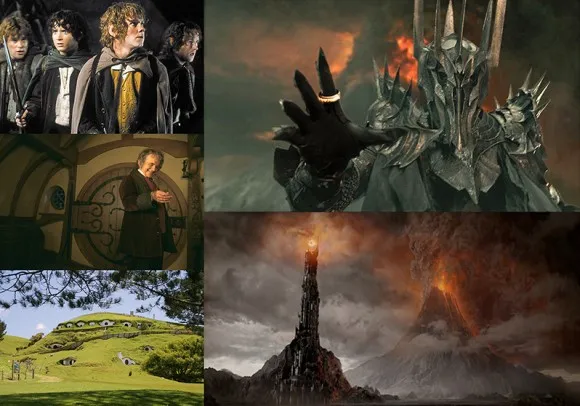
Lord of the Rings Trilogy (2001-2003), directed past Peter Jackson, New Line Cinema
These concepts of harmony and racket can be seen in the Lord of the Rings Trilogy, where nosotros take the proficient-natured Hobbits on one side of the shape spectrum of emotions. Everything about them references the innocent, youthful circle: from the curl of their pilus; their rounded shoulders and shirt buttons; to the round Hobbit holes; and even the curves of the landscape. At the other stop of the shape spectrum we find Sauron, who is aligned to the ambitious triangle: from his sharp fingertips; to the triangular volcano on the landscape.
This contrast of primary shapes allows us to reduce the story of Lord of the Rings to an abstract visual narrative using basic shapes, which sees the round Frodo and Samwise leave their round home to journey to a threatening, angular landscape, before returning to the prophylactic of home.
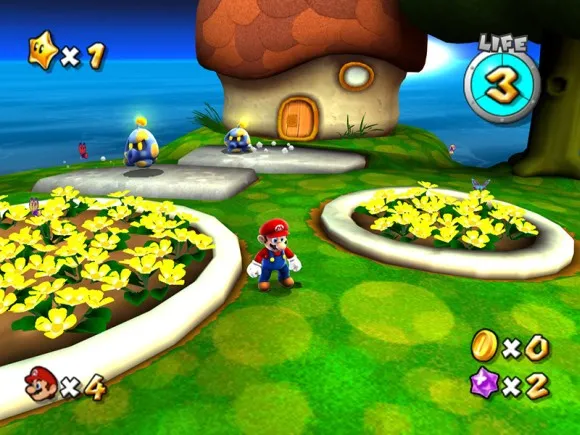
Super Mario Galaxy (2007), Nintendo
As with the Lord of the Rings moving-picture show trilogy, the Super Mario Galaxy serial of games tin too exist reduced to an abstract visual narrative. We have the spherical Mario in his spherical globe filled with triangular enemies. It's the player's part to help Mario clear the galaxy of triangles to restore a harmony between Mario and his dwelling house surroundings.
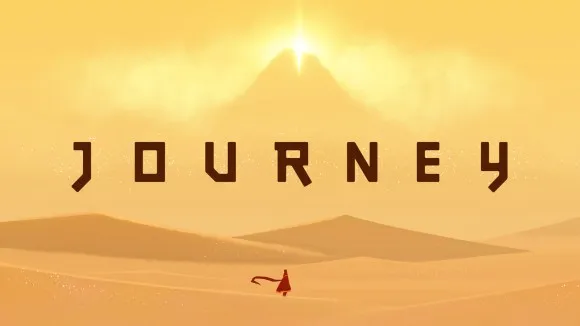
Journeying (2012), thatgamecompany
Journeying is a nifty instance of grapheme-environment harmony using triangular forms, which are echoed in the playable character'south shape and throughout the landscape. Interestingly, the non-aggressive nature of the game's experience could have been rendered using sugary, rounded forms, but the game's pattern is all the better for going confronting conventions by creating a contrast between the character's edgy class, and its delicate movements and jump arcs.
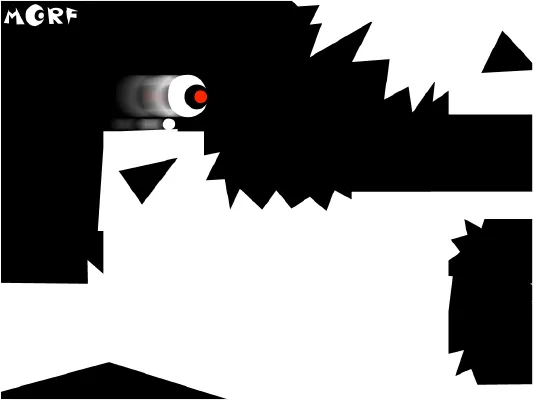
Morf (2011), SOLARSKI STUDIO
Morf is a simple browser-based game that I developed to explore the emotional links between character and environment shapes. Yous, the player, must guide a round character through two environments -- ane circular, and the latter, sharp. The surprise awaiting players is that, technically, both environments are identical -- it's only the superficial surface graphics that modify. Yous tin play the game past visiting my folio.
I had the opportunity of testing Morf on both experienced gamers and non-gamers. Experienced players were naturally well-versed in the linguistic communication of video games, and were therefore primarily concerned with testing the game'south dominion system: Can I bound higher if I run and jump? Tin the character die if I impact a spiked object?
Not-gamers, on the other hand, were acutely enlightened of the game's visual pattern. They would crash-land their style through the round level without concern, but upon reaching the edgy leve (pictured higher up)50, they would spend an inordinate amount of fourth dimension advisedly avoiding sharp objects. When their grapheme would accidentally land on a fasten, they'd exclaim words like "ouch!" -- words that we apply when nosotros hurt ourselves in reality. We should be very proud that video games tin can evoke such responses, since they're unique among artistic disciplines, and illustrate the histrion's strong empathy for their on-screen graphic symbol.
This heightened emotional response from non-gamers suggests that at that place exists an even greater potential for artistic video games. Non-gamers -- representing a huge, and disregarded audience -- accept a significantly lower concern for the rules of a game (and an even smaller technical understanding), and are therefore more ready to append their disbelief and simply experience. This should be a strong telephone call to action for developers to explore games that are not targeted at hardcore gamers.
We've looked at how character shapes, character animations, and environment shapes can be shaped to influence the artful experience of a video game. Our analysis uses the emotionally charged primary shapes -- the circle, square, and triangle -- as a conceptual tool to brand sense of a wide variety of artistic styles and interactions. In the side by side department we will explore how pathways inside a video game environment can also influence the emotional experience within the context of dynamic composition.
Pathways
The pathways within an environment -- merely like the pathways in a park, or pavements in a city -- tin readily be reduced to systems of lines. The shape of a path has a strong physical and emotional influence, which is the reason why pathways in parks tend to take leisurely curving shapes, for instance.
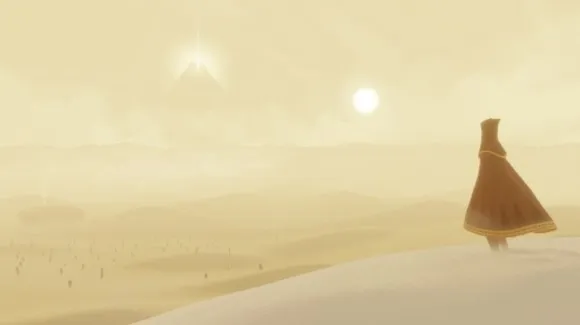
Journey (2012), thatgamecompany
Journey's opening level has no explicit pathways whatsoever. We can fittingly utilise the concept of an open canvas to this level, if you imagine the grapheme every bit the tip of a pencil or paintbrush. What the designers accept washed is to give players the liberty to draw their way through the environment in whatsoever way they wish.
However, the lines that players are able to describe have been restricted to i style that fits the aesthetic feel -- with delicate gestures of the character, which we explored in the previous department on character blitheness.
The pathways in Journey become more explicit and constrained as the narrative drops to the darker, moodier mid-bespeak of the game -- thus creating an abstract narrative of liberty versus confinement.
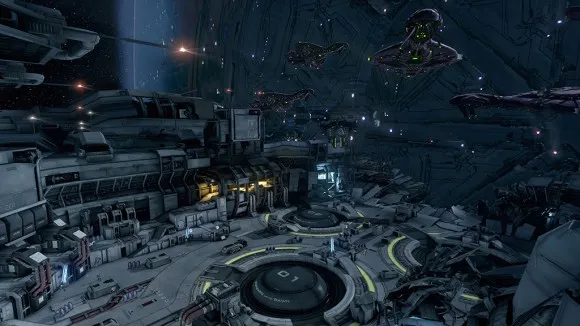
Halo four (2012), 343 Industries
We already looked at how Primary Principal's movements and in-game camera distinguish themselves from the ambitious movements of Gears of War. Games in the Halo franchise further differ themselves from many other get-go person shooters because they oftentimes feature rounded and organic pathways. We know from previous examples that rounded lines accept a gentler aesthetic quality -- aligning themselves with the composition lines in Vermeer'due south Diana and Her Companions.
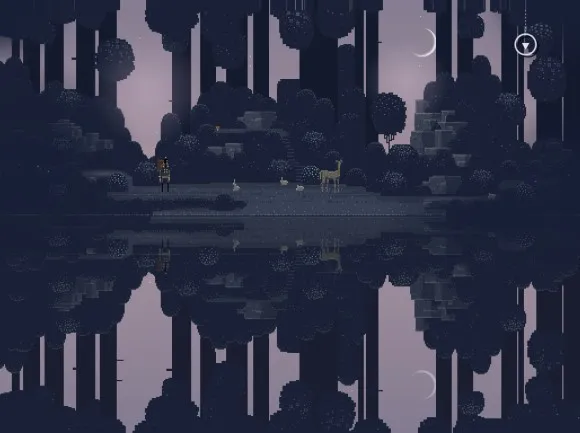
Superbrothers: Sword & Sworcery EP (2011), Capybara Games
Moving forth the shape spectrum of emotions we come up to the straight upright and horizontal lines found in Superbrothers: Sword & Sworcery EP . Although conflict does feature in Southward:S&S EP, the game has a very tranquil aesthetic generated through a sensitive choice of environment shapes.
Imagine how dynamic the game would visually announced if all the trees in S:S&S EP were titled to one side, creating a chevron upshot on business relationship of the reflection in the water. As information technology stands, the game's sense of tranquility is, in part, created by the verticality of the background, and the horizontal and vertical pathways along which the character travels. For comparison, call up back to vertical lines of Piero della Francesca'southward The Baptism of Christ, in the earlier department on classical composition.
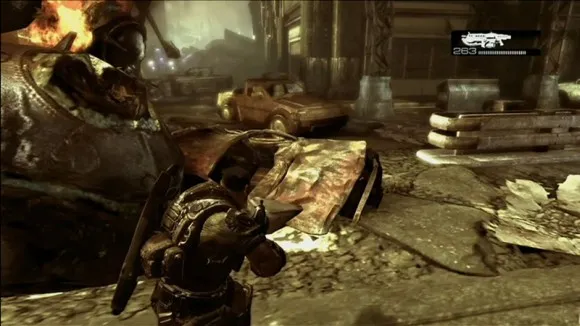
Gears of War, Ballsy Games
If nosotros brand an environment'south pathways angular, the visual and interactive experience instantly becomes more than aggressive -- an aesthetic quality perfectly suited to the Gears of War franchise. Accept a moment to consider how the pathways in the three-dimensional surround above reflect the athwart limerick lines in Massacre of the Innocents by Rubens.
We've now examined the four aspects of dynamic composition that relate to the on-screen visuals of a video game. Collectively, these conceptual tools requite u.s.a. more control over a game'due south aesthetic feel, and permit us to create complex narratives. Before applying these techniques to game blueprint, we'll examine an aspect of video game aesthetics that is fairly unique to the medium as information technology relates to interactivity, which creates a form of artistic collaboration between a game's designers and the players.
Player Gestures
The elements of dynamic limerick that we've explored upward till now take been restricted to visual images on screen -- images that respond to the player's inputs. Therefore, to fully appreciate the aesthetics of video games we must also consider the performance role of the actor, which is closely aligned to that of the creative person.
Motion controllers are particularly useful at illustrating the histrion's artistic involvement in video games. Motion controllers include Microsoft's Kinect, Sony'southward PlayStation Motility, and Nintendo'south Wii, and any input that allows players to command on-screen elements using physical gestures.
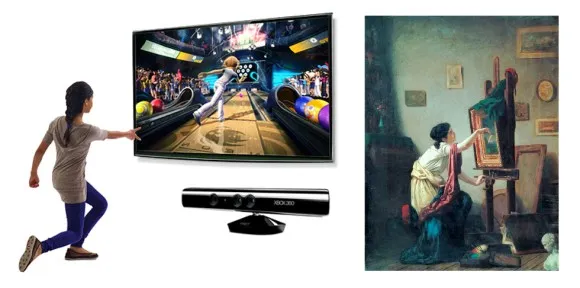
Motion control mechanics that go beyond fitness and washing games are grossly underdeveloped, because their applied potential is massive. Never earlier has the function of the audience/player been so closely aligned to that of the creative person/game designer. Consider the following analogy:
Every traditional painting was constructed by an creative person using various combinations of lines and shapes. Each line placed on the canvas required a physical gesture from the artist, which inverse depending on whether the line was soft and delicate, or aggressive. Viewers of the artwork would then passively respond to the artist's aesthetic choices and brushwork past exploring the artwork visually.
The same is true of video games -- only the lines and shapes in video games are represented equally dynamic elements, such as the bound arc of a grapheme. The actor responds to these on-screen shapes in much the same manor equally if they were looking at a painting. Withal, video games go 1 pace farther: upon creating a video game, the game'south designers requite creative control to the player through interaction, assuasive players to feel the very aforementioned sensations that a traditional artist would feel when painting.
To experience these creative gestures, compare the differing control sensations for two games that utilize Nintendo's Wii Remote: Mario Kart Wii and Tron: Evolution. Mario Kart Wii'south vehicle treatment is more forgiving than Tron's Light Cycles, which reference the sharp turns seen in the original Disney motion picture. The video in a higher place features both games, although I recommend actually playing them to fully appreciate the effect.
The softer animations and tracks of Mario Kart Wii have the role player tilting the controller using gentler physical gestures. The abrupt handling of Tron'south Light Cycles means that players must utilise corresponding physical gestures to command the vehicles.
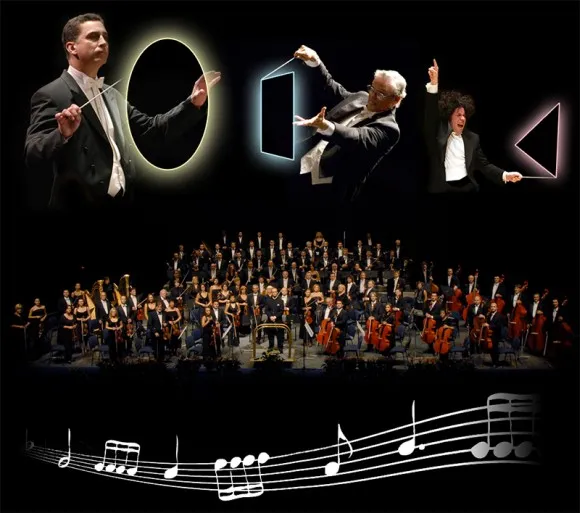
This linking of on-screen animations straight to the player's physical gestures is an interaction unique to video games. My favorite metaphor for this artistic collaboration -- and one that I'm applying to one of my electric current video game projects -- is that of the actor as music usher.
In this metaphor, the orchestra playing a scripted piece of music represents a video game experience created past a team of designers (the composers). The player (music usher) activates the music, feeds it impulses, while responding to the music physically and emotionally.
Imagine yourself a music conductor waving a conductor's baton while listening to the three songs in the above video. What type of gestures would you make to comport each piece of music? The gestures you create are closely related to the type of gestures that players tin be prompted to perform when playing video games using motion controllers.

Music, just like visual images, can exist conceptually reduced to circles, squares, and triangles. Each vocal and corresponding music conductor'southward gesture creates dissimilar aesthetic sensations in the player. This combining of aesthetic elements allows us to re-imagine video games, such as Super Mario Bros., and conceptualize the jump arcs of Mario equally a tune that could be controlled with a motion controller.
Now that we accept a good overview of video game aesthetics -- including grapheme shape, character animations, environment shape, and pathways -- and the player's office in the dynamic artwork, nosotros can go about applying our noesis to artful game design, and explore the possibilities of stronger collaborations between artists and game designers.
The Aesthetics of Game Blueprint
This section explores game design from a gameplay perspective, in the sense of games as systems of rules. Gameplay also has aesthetic qualities if we conceptualize games as shapes. Primal to this conceptual view is the agreement that games are vehicles for activating stories. Even traditional games like chess requite players a purpose to act upon, and construct their personal narrative inside the play area. Today's video games are capable of activating stories with infinitely more complex narrative structures, on business relationship of the medium'southward dynamic and interactive backdrop.
We've seen through the above example of dynamic composition that classical art, and video game art is linked by a common visual grammar. Nosotros must only consider how interactivity affects traditional blueprint principles to reveal these links. Video games are clearly not a revolution in art history, only an evolution.
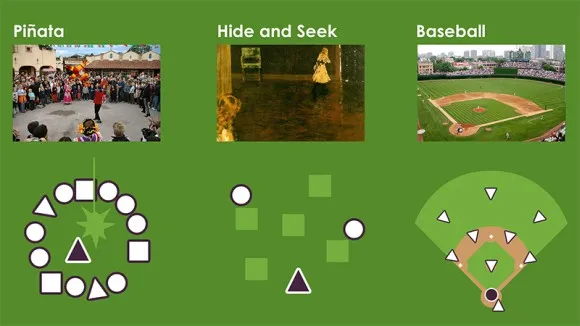
The higher up illustration features three games -- piñata, hide and seek, and baseball. The principal actor in each game has been highlighted in purple. The rules of each game dictate the shape of the play area, and the system of participants. Every bit we know full well, shapes -- the circle, square, and triangle -- have strong psychological furnishings on u.s., the viewers, so information technology's important to examine how a game's shape may influence players emotionally.
Piñata plants a single person in the middle of a circle defined by friends, family, and acquaintances. The circle serves as a safe infinite of encouragement while the player blindly tries to hitting the hanging piñata. The shape of hide and seek is very different because in that location is an absence of other players from the point of view of the seeker. Baseball has a very confrontational shape, from the point of view of the person batting, confronted by eight fielders facing her or his direction.
If nosotros were to aesthetically enhance each game -- manipulating photographic camera angles, framing, animations, color, etc. -- we could, for instance, brand hide and seek visually exude loneliness, much like the solitary figures inhabiting Giorgio de Chirico paintings. Nosotros could then imagine combining all three of these games into 1 narrative, and then that each game represents a narrative human activity. A player of our hypothetical three-act game could be fabricated to experience joy in Act 1 (piñata), loneliness in Act 2 (hide and seek), and aggression in Human activity 3 (baseball).
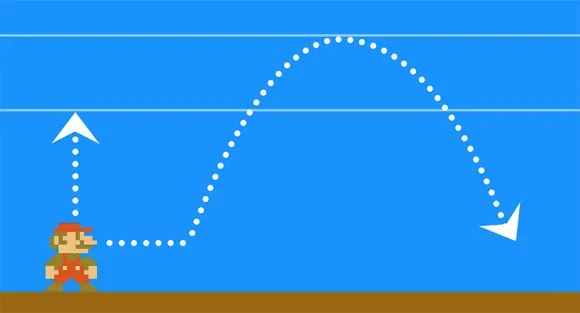
From the perspective of gameplay, we could also pattern a new range of role player animations -- within the confines of each game'due south existing rule-set. Have, for instance, the range of moves available to Mario in the original Super Mario Bros. game from Nintendo. Mario could achieve greater jump heights if he did a running jump.
Such blueprint choices were one time exclusively a question of gameplay, and not aesthetic choices, on account of gaming's technical limitations. Just as we saw in an earlier video -- featuring Journey, Superbrothers: Sword & Sworcery EP, and Vanquish -- game blueprint and game art is now significantly more than sophisticated, so that a character'due south available movements and actions tin can attach to a game'southward rules, while also being aesthetically pleasing and varied.
For our iii act video game -- inspired by piñata, hide and seek, and baseball -- nosotros could therefore take the playable characters dynamically change their shapes and animations between narrative acts. The dynamic and playful movements of Mario in Super Mario Milky way could inspire the animations in Act 1 (piñata). Feelings of loneliness in Act two (hide and seek) could be enhanced with animations referencing Superbrothers: Sword & Sworcery EP. The final confrontation in Human action iii (baseball) could take its pb from Gears of War.
The results of this particular example would not necessarily brand for an elegant creative experience -- all the same this hypothetical game serves only as an example for the aesthetic possibilities of gameplay that fully accept advantage of dynamic design. No longer must nosotros stick to the formula of designing games that follow a constant set of rules, which is a concept rooted in traditional board game pattern. Armed with knowledge of dynamic composition and traditional art principles, we can begin designing games based on aesthetic qualities, while additionally incorporating dynamic gameplay, to create experiences with more than emotional depth.
Breaking Conventions
Because every aspect of a video game -- the visuals, interactions, and game design -- have artful qualities, we can begin making stronger bridges between the disciplines of game design and art if we're to rival the traditional arts in creating meaningful and varied artistic experiences.
To create bully, emotion-driven games we must start each projection by request the question: what is the emotional experience? Our misguided tendency is often to atomic number 82 a game's blueprint by its genre or fashion.
If nosotros practise it right, we tin begin creating in-game narratives using the strengths of the medium -- without over-reliance on cutting-scenes, dialogue, special effects, and user-interfaces. Interestingly, such a shift volition align video games closer to operation arts such every bit ballet, than motion-picture show, where motion and music (and interaction) lone tell a story. For this to happen the whole development squad must be versed in the concepts of dynamic composition. To summarize, dynamic composition is primarily concerned with:
- Character shape
- Grapheme animations
- Environment shape
- Pathways
These unassumingly unproblematic techniques give us a common linguistic communication with which to communicate beyond the various disciplines of art, game blueprint, and programming constitute collectively in video game development.
The triangle in opposition to the circle has been a common theme throughout this article because these 2 shapes correspond a polarity on the shape spectrum of emotions -- much like blackness and white on the value calibration. Each shape is visually and psychologically distinct from the other. Such contrast is an essential component of storytelling, sparking conflict and action within the narrative, and an emotional disharmonize within the audience. Which is why, throughout fine art history, the circle and triangle have been used abstractly to define two opposing forces.
Whichever shapes you lot cull for your game's characters, information technology's important to be aware of contrast equally a narrative tool, and to be prepared to opposite the polarity of characters for dramatic event. Dissimilarity also makes it easier for your audience to orientate itself on the emotional stage of the narrative.
Keep in listen that dynamic composition and primary shape concepts should not be used formulaically. Using your intuition and going against convention is more desirable. For instance, a character that appears villainous in appearance, merely turns out to be a hero, will surprise players, and make their experience emotionally richer and more engaging.
I'll get out you with a quote from Christopher Vogler, advising how readers of his fantastic book -- The Writer's Journey: Mythic Structure for Writers -- should approach the hero's journey metaphor, which provides a similar conceptual function for narrative to that of dynamic composition for game art and game blueprint:
"If you get lost, refer to the metaphor as you would cheque a map on a journey. But don't fault the map for the journey. You don't drive with a map pasted to your windshield. You consult it before setting out or when you get disorientated. The joy of a journey is not reading or following a map, but exploring unknown places and wandering off the map now and then. Information technology's simply past getting creatively lost, across the boundaries of tradition, that new discoveries can exist made."
---
Drawing Basics and Video Game Fine art: Archetype to Cutting Edge Art Techniques for Winning Video Game Design is bachelor on Amazon and Barnes & Noble.
escarcegalostower.blogspot.com
Source: https://www.gamedeveloper.com/design/the-aesthetics-of-game-art-and-game-design
0 Response to "Illustrating Characters and Enviromants for Multiple Games and in Various Art Styles"
Post a Comment